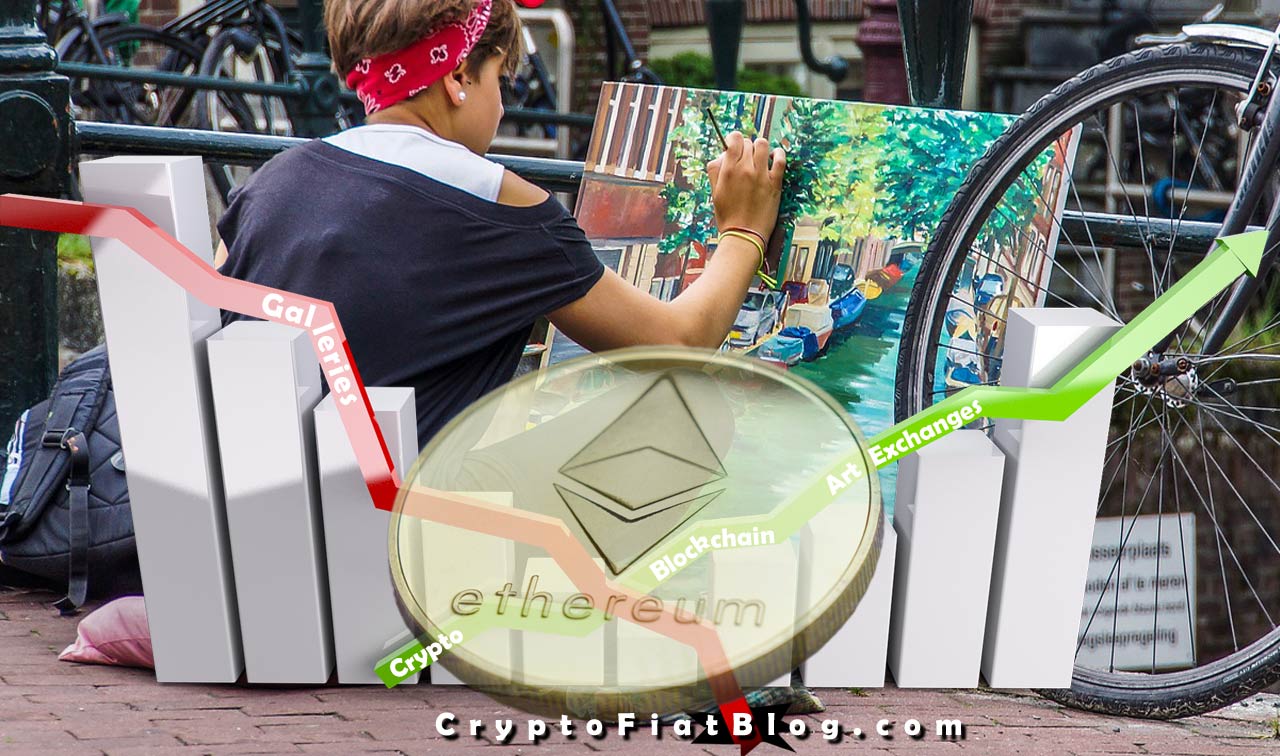
Written by Maurice Cardinal
In Part 1 of this 2 part series we explored stats from an *Artsy survey about art galleries and online sales. In Part 2 we look at how cryptoblock art marketing networks tie it all together for artists – the creators, and for collectors, buyers, and galleries – the traditional sellers. Today, artists are taking on a more active role as sellers by either working in closer partnership with galleries, or doing it on their own through online platforms and cryptoblock art exchanges.
The correlation between the analog and digital worlds of art sales and marketing has a lot to do with “hunger-to-succeed” and “age”. First you need drive, and then you need to know how the world “currently” works around you. Things move fast, which is good because change provides new opportunity.
In this volatile world of cryptocurrencies, blockchain, and art, here’s what I know for sure.
I co-managed a crossover superstar who sold over 55 million albums and well over 3 million concert tickets in places like Royal Albert Hall and the 65,000 seat Houston Astrodome. I learned back in the day (late 80s) when the internet first spawned MP3 – the magic elixir that allowed musicians to easily share their music online, that everyone, and I mean E V E R Y O N E especially musicians – the artists, thought for sure that they would be free forever from the shackles of big record companies. They naively believed they would all become rich and famous just like Bono or Whitney because they all thought their talent was better than the next guys.
Musicians rightly felt that big music corporations were taking advantage of them, and they couldn’t wait to be free of restrictive agreements. It worked great for early adopters because excitement drove it, and then artists started to harshly realize that music doesn’t sell itself. Simon Cowell quickly showed everyone on Pop and American Idols, that there is so much great talent out there it could choke a pig. He proved beyond a doubt that talent isn’t that big of a deal, because the reality is that everyone who wants to do a little work seems to have oodles and oodles of talent. How many times have you watched those shows and went HOLY HOLY CRAP! after seeing six incredible singers in a row who were better than anything currently on the charts?
The secret isn’t in having talent. The secret is getting your work in front of a prospective buyer who intuitively loves your work. When you do that, your work does in fact sell itself, but getting there takes a lot of very hard work and money. The hard part is getting a prospective buyer to be exposed to the type of art that turns their crank, and at a time when they are receptive. The buyer quite literally has to think like the artist, and vice versa. In this transparent era, you can’t hard-sell art. Either you like the piece or you don’t. You can however hard sell art investment, and that’s where galleries and reps come in. They are expert sales professionals who know how to put your work in front of the right buyer at the right time.
Just for clarity, yes there are supremely talented artists who often do things naturally without breaking a sweat, but they are few and far between. For the most part, successful artists are just plain hard workers who really know how to network. It used to all happen at parties, and it still does to some extent on the old boy’s circuit, but then Millennials figured out the sting and turned their backs and wallets on greedy opportunists.
Artists complain all the time that galleries and managers take 50% of their sales, but at the end of the day when all their art is still locked away in their studio, and it sells for nothing, the artist gets nothing. They then have to go to work doing something they hate just so they can eat and paint another canvass that will inevitably end up in their closet or on their mother’s wall.
Cryptoblock art exchanges eradicate this dystopian nightmare. In simple terms, exchanges are nothing more than dating sites that will replace old school galleries that fail to keep pace.
The reality is that cryptoblock, artists, and galleries will still have to work together, but this time around, just like musicians did, artists will have more say in how they are marketed, and they’ll do that by actually becoming part of the process. There is no free ride or lunch, but there is Uber and Lyft to get you there much cheaper than hailing a hack.
On the art buying side, older Millennials and younger Gen-X’rs are an economically powerful group who have established themselves in the workforce–some for almost two decades, plus a growing number are successful entrepreneurs.
As we saw in Part 1, the current influential players in digital art are Millennials who in 2019 are in the 23-38 age range (1981-1996) – in this instance it creeps a little higher to about 45 into young Gen-X territory. Also, the ratio of men to women is high in the art demographic just like it is in tech. However, Millennial FEMALE c-suite execs and owners who are successful in a variety of industries are also being drawn into the mix because of their love of art and an interest in safely growing their wealth. Professional women use sophisticated technology daily in their careers and are comfortable managing data.
Millennial women regard digital art as an enjoyable and relatively easy investment.
Cryptoblock digital art exchanges, although still in early growth stages, are bringing genders together in a marriage that benefits everyone, including artists, because it makes it easier, safer, and fun again to by art.
Even though Boomers (who in 2019 are 54-72 years old) still buy the most art overall, Gen-X and Millennial men and women live in an “always-on” technical environment and know how to use social media for commerce better than any other demographic. This group makes up almost 65% of the online contemporary and modern art buying market.
If you’re an artist or a gallery, you need to ensure this group finds you.
Europe, recognized as a leader in fine art consumption, has the highest global percentage of online-only galleries—*33%, which is double the overall average of 15%.
Compared to other regions, in 2019, according to the Artsy survey, galleries in Asia and the Pacific Rim are the ones to watch–37% reported that they are “very likely” to invest in technologies that will help them sell art online.
Buyers in China are gorging on contemporary art – Hong Kong especially! … According to Forbes, Asians are buying ravenously from artists all over the world. Digital art is considerably more liquid then physical art. Not only is art an investment, for some Asians it also provides a way to quickly move money around the globe. In the last decade especially, fine art has been a well-known tool to move funds unencumbered from country to country. Cryptoblock makes it seamless and much easier.
Galleries in the U.S. and Canada also feel that selling art online is critical to success in 2019. Over *50% of North American galleries report that selling art online was “very important.”
Cryptoblock art takes online selling to a level never before possible. It allows buyers and sellers to be either fully transparent, or easily anonymous. The choice is yours respective of each party or project and the agreement.
Regardless of being transparent or anonymous, cryptoblock art makes it easy for sellers and buyers to find each other whether you are an artist, a buyer, collector, gallery, museum curator, or otherwise.
Artists like Doriz (at left) who already have a great web presence will find it easy to take the next step to the cryptoblock art platform, and overnight will be able to reach buyers who have very specific interests in the type of abstract art she creates. Once the specifics of the art piece and sales transaction are entered into the “blocks” of the blockchain, the information will then be represented as a non-fungible token, which means it can’t be hacked, or even purposely changed unless 51% of the blockchain mutually agrees.
Art thieves or untrustworthy players can’t manipulate the price, provenance, or other elements crucial to identifying the art work, including protection of the ownership and transaction(s).
As long as the art has been identified and confirmed by experts or the artist as an authentic piece, a fake copy of the artwork cannot be substituted because each file contains an identifying number that becomes an indelible part of the digital file. It’s déjà vu WYSIWYG all over again – what you see is what you get!
The value of the art is ingrained in the crypto token, and not the physical work of art.
That small difference makes all the difference in the world – so read the preceding line again!
This native security feature provides everyone with peace of mind that formerly was never available in any format. Artists can now relax knowing their work is safe. They have no reason not to be online, as do galleries. It applies to the Masters as well as emerging artists.
CryptoKitties is the current global leader in this digital art arena, but a few others are experimenting with the process too, and some are exclusively focusing on the fine art market.
As a first-ever additional benefit, galleries and artists can also sell “fractionalized” portions of the art piece in a way very similar to how you would buy shares in a public company on the stock exchange . . . well, not quite, different regulations – but more on that in another article. It means an independent group of collectors and art buyers, known or unknown to each other, today can purchase as little as say, 0.001% of a Monet, or a Warhol, and in the very near future, also buy fractionalized art created by the abstract painter next door.
The intuitive, automated agreement is relatively easy to set up using a SMART CONTRACT and also easy to manage. The Ethereum cryptocurrency coin has smart contract functions seamlessly built into it, as do a few other crypto coins – but NOT Bitcoin. Some argue it’s Bitcoin’s Achilles heel, and the reason why it isn’t a good business tool. Bitcoin however, is without doubt the gold standard in the crypto world to hold and trade monetary value.
Most of the marketing magic happens within the “smart contract”, which is basically just an agreement that sits on a series of decentralized blockchain servers usually spread among many different countries. In the past, a single company, like Sotheby’s for example, monopolistically controlled all the information from one central place, and as a buyer and often even an artist, you had little knowledge of exactly what the information was until you signed on the dotted line. By that time it was often too late. Today, through the innovation of AI, artificial intelligence built into a smart contract, both seller and buyer can instantaneously make critical decisions based on accurate and immutable pre-loaded data.
 For example, when you see a piece of art on the Blockchain Art Exchange by an artist like Maximillian W for example (at left), you can easily research the data attached to the work, i.e., the artist, when it was produced, the medium, country of origin, etc., and you can be assured that the information is accurate and can’t or hasn’t been fraudulently changed.
For example, when you see a piece of art on the Blockchain Art Exchange by an artist like Maximillian W for example (at left), you can easily research the data attached to the work, i.e., the artist, when it was produced, the medium, country of origin, etc., and you can be assured that the information is accurate and can’t or hasn’t been fraudulently changed.
Art exchanges are also developing innovative features that will allow you to see how many times a piece was bought and sold, and for how much, plus you can choose whether you want to purchase a digital file to display on your phone, or a hi-res version that allows you to display FINE ART on a large screen HD art monitor, or maybe print it at a variety of specific sizes to hang on the wall of your home or in a corporate boardroom. The art can also be licensed to display in public spaces, for example the lobby or hallways of institutions like hospitals–and again, even on large screen monitors in their private or public spaces. Some of these features already exist at some exchanges, and some are in the works!
Smart contracts, to simplify, are nothing more than lists of data attached to checkmark boxes that you intuitively select on your computer screen. Each time you check a box it customizes the licensing or ownership agreement in real time. The smart contract automatically runs, in a millisecond, an “if A then B then C” computation, and when you answer all the questions by choosing the boxes appropriate to your needs, you then click “PURCHASE”, the sale is complete and the digital file is delivered to you immediately to be used or traded as agreed and licensed.
No haggling, no middleman, no hassle, and no worries.
This car drives and parks itself.
All it needs is a little gas – as in crypto!
How smart is that?
Read Part 1 – Cryptoblock Art – A New Investment Frontier
::::::::::::::::::::::::::::::::
 Author Maurice Cardinal is an advisor at International Artist Day, and a Blockchain Development Advisor and a Crypto Content Specialist. Maurice has helped develop successful blockchain strategies and ICO campaigns for the news, gaming, healthcare, and cloud computing industries, and has researched, written, and advised about blockchain and cryptocurrency strategies for several years. Maurice is also the author of Leverage Olympic Momentum an early adopter business bible about disruptive marketing and growth hacking. He is also the Editor of CryptoFiatBlog.com
Author Maurice Cardinal is an advisor at International Artist Day, and a Blockchain Development Advisor and a Crypto Content Specialist. Maurice has helped develop successful blockchain strategies and ICO campaigns for the news, gaming, healthcare, and cloud computing industries, and has researched, written, and advised about blockchain and cryptocurrency strategies for several years. Maurice is also the author of Leverage Olympic Momentum an early adopter business bible about disruptive marketing and growth hacking. He is also the Editor of CryptoFiatBlog.com

